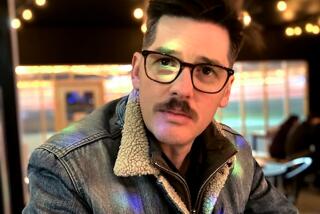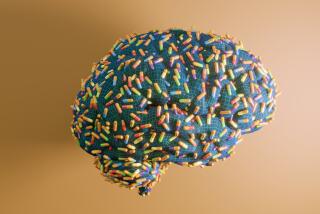In her debut memoir, notorious writer Cat Marnell apologizes for nothing
Ask Cat Marnell, the former Condé Nast beauty editor who has documented her decades-long drug addiction in shamelessly scandalous columns for Vice and xoJane, whether her new memoir, “How to Murder Your Life,” glorifies drug abuse, and she doesn’t skip a beat. “Sure! It’s glorious,” she breezily replies. “Drug abuse: It’s fun.”
Marnell’s authorial debut is noteworthy for its compelling twin narratives of a rising young talent in the rarefied world of pre-2008 print publishing and of her simultaneous downward spiral into a death-defying feedback loop of substance abuse, insomnia, bulimia and violent relationships — all told in a prose style that is like a spit in the face to an English teacher or to the notion of authority altogether. Her signature emphatic all caps and charmingly sarcastic colloquialisms, her crass irreverence and staggering self-awareness, are themselves, forgive the figure of speech, addictive.
But Marnell’s foray into the literary world is also raising a stir because, unlike many addiction memoirs, hers does not end in neat, fairytale sobriety. She is to this day unapologetically a self-described addict.
I arrive at her Chinatown apartment at 7 p.m. and Marnell greets me in the stairwell, surprisingly upbeat, if frazzled. Dressed in loose jeans, sneakers, a white wife beater and a wig of long, robin’s egg blue hair, she breathlessly explains she just cannot stand to talk to another journalist in this apartment.
Walking into the spacious, white-walled one-bedroom, I am disappointed that I won’t be staying long. The space immediately feels rife with evidence of its inhabitant, the stuff of both her dreams and realities in full view: the half-eaten sandwich, empty smoothie containers and takeout bags, dirty laundry on the floor, stacks of years-old fashion magazines and a Bambi poster prominently displayed above the couch. In one corner stands a geometric, Styrofoam, floor-to-ceiling bookcase: “How to Quit Drugs for Good,” Bret Easton Ellis and Mary Karr, Judith Witt’s “McQueen” and “The Vogue Book of Blondes.” (In “How to Murder Your Life” she describes her all-night, Adderall-fueled episodes of sleepless energy and almost inhuman productivity: Perhaps one of these is responsible for the volumes’ meticulous color-coding.) She tells me Oprah has the same shelf.
After several minutes and outfit changes, Marnell reappears in the same T-shirt and jeans with a zip-up hoodie, even though she says she is self-conscious about it revealing the sizable rash across her neck. As is the case with her recent hair loss (hence the wig), Marnell can’t explain this mysterious symptom either, and she doesn’t trust doctors. About the hospital bracelet around her wrist, she insists, “This is real. I have it because when I saw how swollen my face looked in the Rolling Stone photos on Tuesday — I looked like that Violet person in ‘Charlie and the Chocolate Factory’ — I went to the E.R. and I demanded to be drained.” It was the same E.R. she’d been taken to for a heroin overdose in 2014. She pops a pill and we head out.
Settled into a booth in a fluorescent-lit, sparsely populated hotel bar on Bowery with glasses of white wine, it at moments feels like we’re just two familiar friends meeting for after-work drinks, prattling about Bieber and living on Canal Street and whether we want to have kids someday (she does) and how the only straight men at Condé Nast are the Urban Express delivery guys (I was once an editorial assistant there too).
She dispels comparisons the media have made between her and the towering figures of last century’s counter-culture literati: “I never read Hunter S. Thompson, but I saw the Johnny Depp movie. I’ve never read … William S. Burroughs. Someone called me ‘Hunter S. Tampon’ on Twitter; I liked that.” Despite her confidence, though, her need to self-protect is unmistakable in both her drawn body language and her habit of qualifying convictions with a compulsive “I don’t know.” This demeanor, on top of her almost animated-doll-like appearance and dainty frame, makes her seem so much younger than her 34 years.
Once she tells me about the audience she envisioned while writing the book, this whole persona, even the Bambi poster, suddenly makes sense. “I wrote it for young, messy people,” she says. “I stopped answering in my head to the people who are going to be writing my reviews and started talking to teens. I wrote it with someone like Bella Hadid in my head.” She explains that older readers are disdainful and make her “feel like a little hobo. But younger kids don’t talk to me like I’m some exploited weirdo. They come to me and want my help. Once I started writing for young people, then I could just be the teenybopper that I am. And that’s when the prose became more bubblegum and I started really enjoying it, because I wasn’t in a defensive place.”
As the book documents, Marnell began taking Ritalin at boarding school at the age of 15 thanks to a prescription provided by her own father, a hospital psychiatrist. “I had a very privileged childhood, but I also had a dysfunctional family,” she remembers.
“Daddy issues are for amateurs,” she jokes, but adds in a serious tone: “My mom was sick: She was anorexic and very closed off. So I never developed that self-parent that was like, ‘Cat, go to bed!’”
Although she still takes amphetamines daily — “Adderall is in my life just as much as food is in other people’s lives” — she swears she has had to cut back on the hard stuff. Despite her larger-than-life tales and crafted image as the delinquent problem child of the Manhattan publishing scene, Marnell says she is actually a “control freak” who takes precautions while using. “I’m very delicate because of how much I’ve messed with myself,” she says. “I can’t do a lot of coke or ecstasy or MDMA like my party friends. I can’t even get as drunk as they can, because at this point my constitution, my brain will not handle it.” Once her glass is empty, she moves on to mine. “We [drug addicts] are told that you either have to get clean or you’re a disaster,” she continues. “But there has to be something in the middle. Can’t people just try to get better?”
So why write the memoir now, then, if she’s still addicted? “I wanted to write honestly, and the reality of addiction is that it keeps going. I did know it was a unique thing to have a book that doesn’t end with recovery, but I didn’t do it on purpose. People have praised that, and I’d rather have the recovery, but that’s just not the truth.”
What’s motivated Marnell to make this ambiguous semi-recovery, if you will, is the same ambitious side that made her so successful as a beauty editor. Once upon a time she idolized the likes of fashion world icon Eva Chen (“I wanted to be her: the Jennifer Lawrence to Anna Wintour’s Angelina Jolie of publishing”), and through all of the career highs and lows since her days at Condé Nast’s tony former Times Square offices, she’s never lost that drive. “I’ve been taking care of myself because I’m proud of this book and I love having a reader. You have to do what you’re good at and then hopefully the addiction stuff will take care of itself.”
At present, a typical day in Marnell’s life involves waking up at around 2 p.m. after staying up until dawn watching bad TV with one of her graffiti-artist friends and immediately ordering food on Seamless: a healthy smoothie with turkey bacon, to eat after she has rapidly consumed and then purged two slices of cake and mozzarella sticks. “When you wake up, you have to answer to your addiction,” she says. “And then I took my Adderall to kill my appetite, and then I had my breakfast. Like, I would never throw up turkey bacon and a smoothie. I just got the bulimia out of the way, and then I lived my day as usual.”
These days, her “usual” includes some combination of seeing her on-again off-again boyfriend of five-ish years (“intimacy is a real challenge because your primary relationship is with addiction”), the publicity circuit (also difficult: “I’m not exactly on top of my ... I’m showing up at a press event like ‘Oh, can you cover up this giant rash?’”), a daily diet of celebrity gossip (“pop culture informs everything that I do”), Barry’s Bootcamp and, yes, working on a second memoir.
“My life got really crazy when I got my book money,” she explains, referring to the highly publicized $500,000 advance she received from Simon & Schuster in 2013. “I got really glamorous, and happy in a lot of ways, but also really sick.” If we thought this one was a trip (no pun intended), she warns, just wait until Part II. “I wrote the first one straightforward. The next one’s getting weird.”
Christensen is the associate features editor at Harper’s Bazaar and has written for the New York Times Book Review. She was formerly an assistant editor at Vanity Fair.
More to Read
Sign up for our Book Club newsletter
Get the latest news, events and more from the Los Angeles Times Book Club, and help us get L.A. reading and talking.
You may occasionally receive promotional content from the Los Angeles Times.






